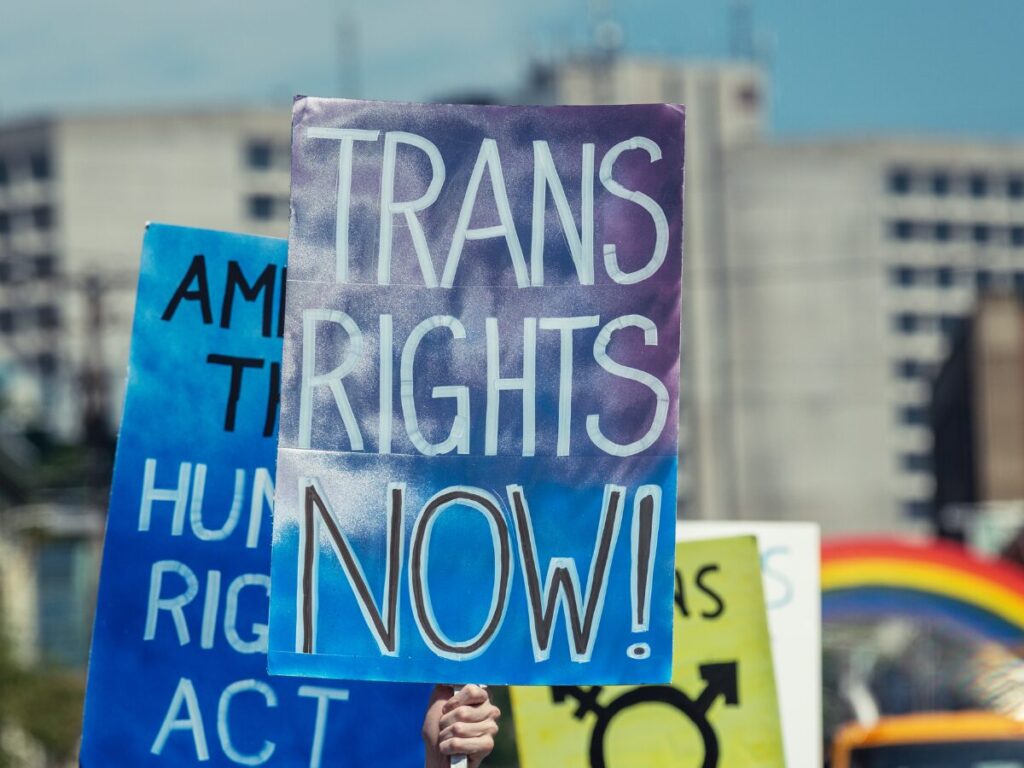We’re living in a time when gender is both everything and nothing. Where trans girls can go viral for their makeup tutorials and become the face of luxury fashion brands while simultaneously being vilified by governments around the world. Still, amid all this flux, there’s one persistent question that seems to scratch at our collective consciousness like a mosquito bite we can’t stop picking: Who gets to be a woman? It’s not a question with a tidy answer. It’s sticky, political, and deeply personal. And yet, it’s a question we must return to once again, especially when discussing women-only spaces.
Let’s start with the basics: Womanhood is not a monolith. It never has been, despite society’s continuous, and often violent, battle to make it so.
For centuries, womanhood has been packaged in a tightly wound box of cis-normativity and white, Western ideals: delicate, maternal, nurturing, fertile. If you didn’t bleed, birth, or bake, were you even a woman at all? These often-colonial ideas of womanhood didn’t just erase trans women. They ostracised cis women who didn’t want children, who couldn’t have them, or who didn’t fit a Stepford Wives aesthetic. This initial definition reduced gender to biology and biology to destiny.
But bodies are messy, and identities are even messier. As the concept of womanhood is manually widened, non-cisgender people continue to be left on the precipice of inclusion. The social consciousness may have progressed, but even now, when people ask: “Who gets to be a woman?”, there is often some historical definition undercutting our answer.

Philosopher and gender theorist Judith Butler challenged the essentialist view of gender in Gender Trouble (1990), arguing that gender is not something one is, but something one does — a series of acts, performances, and social scripts repeated over time. From this lens, “womanhood” is not a biological certainty, but a constructed identity shaped by social expectations. To define womanhood solely through cis-normative criteria, then, is to reify the very gender essentialism that feminist theory has long sought to dismantle.
A gym with no room
Take, for example, the recent controversy surrounding The Girls Spot, a women-only gym in London founded by fitness influencer Natalee Barnett. Initially, Barnett championed inclusivity, stating in 2021, “Respectfully, if you have a problem with trans women attending my gym then you can find another gym to train at.”
However, in March 2025, as the gym prepared to open its doors, Barnett announced a shift in policy. The Girls Spot would operate as a single-sex space for “biological women” only.
The backlash was swift and intense. Supporters felt betrayed, then began to question the implications of such exclusion, asking how the gym would enforce its policy while expressing concerns about the message it sent to trans women seeking safe workout environments. Barnett responded by offering refunds to donors who felt misled and reiterated her commitment to creating a safe space for cisgender women who have faced harassment in traditional gym settings.
But this raises a second question. Can safety for some be built on the exclusion of others?
Activist, journalist and founder of TransActual Jane Fae doesn’t think so.
“Beware of this trick. This illusion. For it is a trap. Designed to keep women down while pretending the opposite. That is why many, many early feminists had no truck with women’s spaces. Because, what are such spaces, after all, if not merely the inverse of men’s space? The country club. The pub bar, at which, for a long time, women were barred (!) from standing.”
The transphobia hidden in “protecting women”
The Girls Spot isn’t the first, and it won’t be the last. From locker rooms to sports teams to bathrooms, there’s been a resurgence of policing who belongs in so-called “women-only spaces.” These arguments usually hinge on an idea of “threat.” The concept that trans women somehow compromise the safety or integrity of these environments.
I now must return to Jane Fae; specially, her explanation that the founding ideology of women-only spaces is anchored by two ideas. The first is “[a] reaction to the identification of all men, everywhere, as potential predators. And trans women have been deemed by some of those arguing this case to be male and nothing but.”

But here’s the thing: this rhetoric isn’t just anti-trans; it’s based outside of tangible fact. According to a 2018 report by the Williams Institute, there is no empirical evidence that allowing trans people to use facilities that match their gender identity increases safety risks in public spaces. In fact, trans people (especially trans women of colour) are disproportionately the targets of violence, not the perpetrators. The Human Rights Campaign reported at least 32 trans or gender non-conforming people were killed in the U.S. in 2024, the vast majority Black and Latina trans women.
These exclusionary policies don’t protect women. They simply redraw the lines of who gets counted as one. Jane Fae’s second ideology that founded women-only spaces echoes this concept: “the postulating of some essential womanity that is forever engraved in the genes, blood, and soul of every woman born woman. Is that Charles Aznavour I hear in the background, singing ‘She’?”
Once we start building fortresses around gender, no one is safe. Not the butch lesbian mistaken for a man. Not the cis woman with broad shoulders or facial hair. Policing gender doesn’t just hurt trans people. If we once again downsize the borders of womanhood, it won’t be long until cis women begin to fall over the edge as well.
If we once again downsize the borders of womanhood, it won’t be long until cis women begin to fall over the edge as well.
Let it be messy
The situation with The Girls Spot isn’t just about a gym. It’s a cultural flashpoint. A case study in how feminism can be weaponised to enforce exclusion. It reminds us that even in “progressive” spaces, trans women are too often framed as problems to solve rather than people to stand beside. If we want to talk about safe spaces, let’s talk about what safety really means. It doesn’t mean shutting the door on trans women. It means creating environments where all women (cis and trans) can move without fear. Without compromise. Without having to prove they belong.
It reminds us that even in “progressive” spaces, trans women are too often framed as problems to solve rather than people to stand beside.
If womanhood has always been a story we’ve told about ourselves, why not add more characters? More nuance? More room to breathe? The idea that gender is fixed, binary, and immutable is a myth. So is the idea that there’s only one “right” way to be a woman.
The truth is womanhood isn’t something you earn. It isn’t something you prove. It’s something you are. And like all identities, it can be messy, evolving, contradictory. That’s not a flaw, it’s the point. There’s a popular talking point in some feminist circles: “We must protect women’s rights.” And yes, absolutely, we must. But if your feminism has room for cis women and not trans women, it’s not feminism. It’s gatekeeping. To divide women is to give us all a class. To define those who society will begrudgingly hold out their hand to, and who will still go without.
Trans women are not a threat to womanhood. Transphobia is. Misogyny is. Patriarchy is. If we want a future where all women are safe, seen, and celebrated, we have to forgo these divided spaces to forgo the system that benefits from dividing us.
So, I return to the same question: who gets to be a woman?
Anyone who says, “I am.”
Let that be enough.












